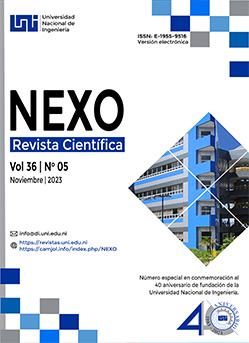Transforming agroindustrial waste into useful products: cement-based on rice husk ash
DOI:
https://doi.org/10.5377/nexo.v36i05.17275Keywords:
alkaline cement, rice husk ash, compressive strengthAbstract
Cement pastes were prepared on a laboratory scale, varying the % of CCA and the % of lime (90-10, 80-20 and 70-30), the % of Na2O used as alkaline activator (6, 8 and 10%) and the setting temperature (80, 90 and 100 ºC). A total of 9 pastes were prepared, obtaining significant compressive strength results at 28 days of curing. The optimal mixture was made with 90% CCA - 10% lime, activated with 10% Na2O in the form of sodium silicate and set at 100 ºC for 24 hours. From the analysis of variance it was deduced that the % of CCA and % of lime is the variable that mainly affects the values of compressive strength obtained. By infrared spectroscopy it was confirmed that the alkaline activation with sodium silicate had an effect on the three-dimensional network of SiO2 of the CCA, generating different reaction products to the starting raw material.
Downloads
Downloads
Published
How to Cite
Issue
Section
License
Copyright (c) 2023 Array

This work is licensed under a Creative Commons Attribution 4.0 International License.
The authors who publish in Nexo Scientific Journal agree to the following terms:
- Authors retain the copyright and grant the journal the right of the first publication under the license Creative Commons Attribution License https://creativecommons.org/licenses/by/3.0/, which allows others to share the work with a recognition of the authorship of the work and the initial publication in Nexo Scientific Journal.
- Authors may separately establish additional agreements for the non-exclusive distribution of the version of the work published in the journal (for example, in an institutional repository or a book), with the recognition of the initial publication in Nexo Scientific Journal.
- Authors are allowed and encouraged to disseminate their works electronically (for example, in institutional repositories or in their own website) before and during the submission process, as it can lead to productive exchanges, as well as earlier and greater citation of published works.











